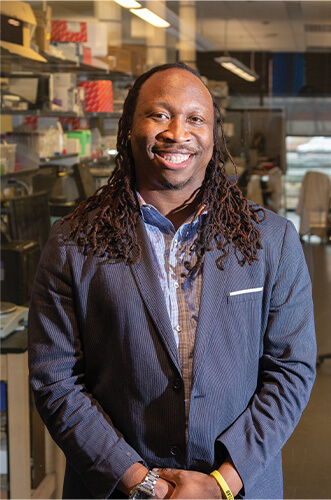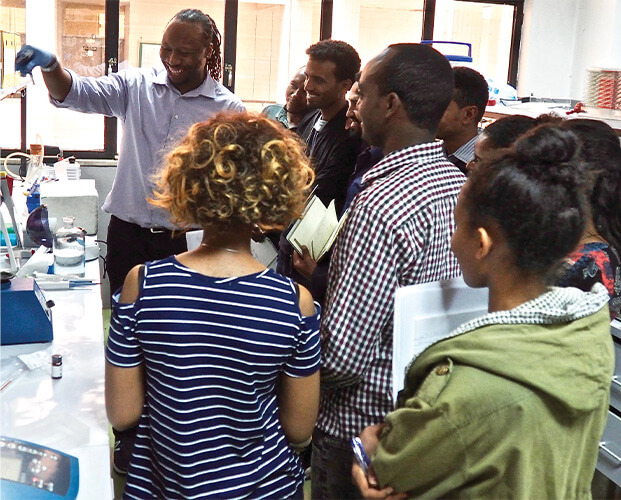BETA Center sets sights on innovation and collaboration, with the goal of quickly responding to global health crises
In Late January 2023, the National Institute of Biomedical Imaging and Bioengineering (NIBIB) launched a new center designed to accelerate biomedical discovery and therapeutics, in part by pulling together expert, multidisciplinary teams from throughout the National Institutes of Health (NIH) to quickly respond when national or global health crises strike. The inaugural director of this Center for BME Technology Acceleration, or BETA Center, is biomedical engineer Manu Platt, Ph.D., (Figure 1) who is also taking on the role of NIBIB associate director for scientific diversity, equity, and inclusion. Platt previously held appointments as professor, Wallace H. Coulter distinguished faculty fellow, and diversity director of the Center on Emergent Behaviors of Integrated Cellular Systems and Cellular Manufacturing and Technologies at the Georgia Institute of Technology and Emory University.

Figure 1. Manu Platt, Ph.D., is the inaugural director of the NIBIB’s new BETA Center. He will also serve as NIBIB’s associate director for scientific diversity, equity, and inclusion. Before joining NIBIB, Platt held appointments as professor, Wallace H. Coulter distinguished faculty fellow, and diversity director of the Center on Emergent Behaviors of Integrated Cellular Systems and Cellular Manufacturing and Technologies at the Georgia Institute of Technology and Emory University. (Photo courtesy of Georgia Institute of Technology/Allison Carter.)
The NIH and NIBIB have already shown their ability to respond to emergencies and assemble effective teams quickly through the rapid acceleration of diagnostics (RADx) initiative that sped the development and commercialization of diagnostic tests to detect the SARS-CoV-2 virus during the COVID-19 pandemic, Platt said (see also [1]). “RADx had to see which COVID tests worked, and how to get them manufactured and distributed, and that took a lot of coordination, much of which was centered in the NIBIB.”
A primary objective of the new BETA Center will be to extend that success by taking a big-picture view when health emergencies arise, as well as acknowledging and dealing with potential obstacles or bottlenecks in development, validation, and dissemination as early in the process as possible. He remarked, “When I hear about the ‘RADx-ification’ of other big needs that might need instant action, the hope is that we will have built coordinated teams in BETA Center that are already working together, appreciate the power each member brings to the team, and can then respond quickly.” Biomedical engineers will participate on the teams to drive the kind of focused engineering approach that will facilitate swift progress, and members from other disciplines will help ensure the best solutions for complex problems, he added. “Clinicians speak a different language from engineers who speak a different language from biologists, and so on, so while all the team members may not be fluent in everyone’s language, they can see how together they can have the most impact.”
Besides paving the way for successful emergency response, the BETA Center will work to encourage intramural collaborations in a wide range of innovative and highly promising areas, such as biomedical imaging, synthetic biology, nano- and biomaterials, and biomedical-related artificial intelligence and machine learning.
Collaborative research is of particular interest to Platt, who has seen its impact on his own active research programs (Figure 2), particularly his work on sickle cell anemia. “We’ve all learned about sickle cell disease in school, back when we were doing our Mendelian genetics and punnett squares, but it affects real human beings,” he said, pointing out that in the global disease burden, 300,000 babies every year are born with sickle cell disease, and 90% of these children die before their fifth birthday. “It is a complicated disease that involves everything from cell membrane dynamics and membrane viscosity to self-assembly and hemodynamics, and it affects every organ system in our bodies,” he described. “So, no matter what you study, there’s a way that your work applies to sickle cell, and if we can mobilize many disciplines to work on it, we could have a great impact on that disease.”

Figure 2. Platt’s research includes working toward solutions to battle a number of diseases, notably those that pose health issues in the United States and also take an especially heavy toll in resource-limited countries. As part of these studies, he has spent time in resource-limited settings, such as South Africa and Ethiopia. Here, Platt meets with collaborators at Addis Ababa University, Addis Ababa, Ethiopia. (Photo courtesy of Manu Platt.)
The same can be said of many biomedical issues, Platt asserted. “Imagine what can happen when you bring in multidisciplinary, inclusive approaches that draw from engineers, clinicians, basic researchers, and others. This is the kind of thing I dream about at night and that got me excited about the BETA Center.”
One of Platt’s goals for the first year of the center is to establish relationships. “I’ve got a team at the BETA Center and together we will be having conversations with researchers at other NIH institutes to gather some thoughts about what it means to be a BETA Center investigator, what benefits the center can provide, and how the center can work with other institutes to share resources.”
A second goal aligns with one of Platt’s career-long priorities: increasing diversity in science and engineering. He hopes to begin exploring ways to bring new and diverse people to the NIH, perhaps by inviting those early in their careers—even undergraduate students—to symposia that feature the cutting-edge work of NIH researchers. “We want to spark ideas and get a diversity of people excited about what it could mean to be an NIH investigator and part of this integrated biomedical engineering team,” he said. “I think there’s a fantastic opportunity for the BETA Center to become a model for diversity.”
Platt will also spend time in the upcoming year getting out the word to the broader, extramural science and engineering community about what the BETA Center is and what it offers. “If we can begin to share the love of what the opportunities are, that might also help recruit new investigators, whether they be junior, mid-level, or senior investigators, to intramural labs at the NIH.”
Despite the very busy year he has ahead as director of the BETA Center, Platt will continue to run his research lab, not only because he hopes to contribute to scientific discovery and medical solutions, but because he will be able to see first-hand the opportunities and challenges that NIH investigators face in building collaborations across disciplines and institutes. He explained, “There’s a value in that I will not just be ‘leading from on high’ and making promises, but will still be in the trenches, and getting feedback from and advising other investigators about building the same kinds of teams that the BETA Center is trying to encourage.”
He added, “My hope for the BETA Center is that we create that safe space where we all can bring ideas to the table, we can all get excited about what it could mean to be an NIH investigator and part of this integrated biomedical engineering team.”
References
- C. Weber, “The RADxSM tech process: Accelerating innovation for COVID-19 testing,” IEEE Pulse, vol. 12, no. 3, pp. 21–23, May–Jun. 2021.



